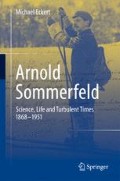Abstract
The posthumous recognition of scholars has a long history. The Paris Academy of Sciences traditionally honored its deceased members with eulogies, establishing thereby a ritual adopted subsequently by virtually every scientific society. Although both the hero worship of antiquity and the hagiography of the Middle Ages live on in this tradition, these eulogies, biographical memorials, commemorative speeches, and obituaries of academics are valuable sources for the history of science, for they reveal what the immediately following generation of an esteemed scientist regards as his most significant contributions. When the work of a scholar continues to be influential years after his death, hagiographical presentation makes way for another form of recognition. His textbooks are revised by his students and published in ever newer editions. Publication of his collected writings facilitates access to his work by new generations of scientists. Congresses at 10-year anniversaries serve to illuminate one or another pioneering accomplishment in light of developments that followed it. In few cases does interest in a scholar spread past this phase and reach circles outside his own sphere of influence. This does happen in the case of exceptional figures such as Einstein and Bohr, who achieved world renown even during their lifetimes, as well as of those whose influence spreads beyond their particular fields to other disciplines. Finally, there is yet another sort of scientific afterlife, when a law, a formula, or a natural phenomenon has been named for the scientist who postulated or discovered it.
Access this chapter
Tax calculation will be finalised at checkout
Purchases are for personal use only
Notes
- 1.
From Niessen, May 7, 1951. DMA, NL 89, 017, folder 2.6.
- 2.
From Anton Weiher, August 3, 1951. DMA, NL 89, 017, folder 2.7.
- 3.
Dingler to Thüring, May 8, 1951. Aschaffenburg, Hofbibliothek, Dinglerestate.
- 4.
Pauli, Arnold Sommerfeld, 1951.
- 5.
Heisenberg, Arnold Sommerfeld, 1951.
- 6.
Ewald, Arnold Sommerfeld, 1951.
- 7.
Bechert, Arnold Sommerfeld, 1951.
- 8.
Laue, Sommerfelds Lebenswerk, 1951, pp. 514 and 518.
- 9.
Born, Sommerfeld, 1952.
- 10.
Kuhn/Heilbron/Forman/Allen, Sources, 1967. http://www.amphilsoc.org/guides/ahqp/index.htm (31January 2013).
- 11.
Heilbron, History, 1964; Forman, Environment, 1967.
- 12.
Hermann, Diskussion, 1967; Hermann, Frühgeschichte, 1969.
- 13.
Sauter, ASGS, 1968.
- 14.
Bopp/Kleinpoppen, Physics, 1969.
- 15.
Sommerfeld, Atombau, 1992.
- 16.
Benz, Arnold Sommerfeld, 1975; Forman/Hermann, Sommerfeld, 1975.
- 17.
Heilbron, Kossel-Sommerfeld Theory, 1967; Nisio, Formation, 1973; Forman, Doublet Riddle, 1968; Forman, Alfred Landé, 1970; Cassidy, Core Model, 1979; Kragh, Structure, 1985.
- 18.
Hoddeson/Baym/Eckert, Development, 1987; Eckert, Propaganda, 1987; Eckert, Sommerfeld, 1990.
- 19.
Eckert/Pricha/Schubert/Torkar, Geheimrat, 1984.
- 20.
Eckert, Atomphysiker, 1993.
- 21.
Eckert/Märker, ASWB, 2000 and 2004.
- 22.
Seth, Crafting, 2010.
- 23.
Sommerfeld, Quantentheorie, 1916, p. 51.
- 24.
Sommerfeld, Atombau, 1919, p. 244.
- 25.
Kragh, Magic Number, 2003.
- 26.
From Heisenberg, June 14, 1935. DMA, HS 1977-28/A,136. Also in ASWB II.
- 27.
Pauli, Beiträge, 1948, p. 132.
- 28.
Schweber, QED, Kapitel 2.
- 29.
Heisenberg, Ausstrahlung, 1968, p. 536.
- 30.
Feynman, QED, 1990, p. 148.
- 31.
Fritzsch, Konstanten, 2003.
- 32.
Sommerfeld, Ergänzungsband, 1929, p. 337.
- 33.
Bethe, Quantenmechanik, 1933, p. 316.
- 34.
Pauli, Beiträge, 1948, p. 131.
- 35.
Heisenberg, Ausstrahlung, 1968, p. 534.
- 36.
Yourgrau/Mandelstam, Variational Principles, 1968, S. 113–115.
- 37.
Biedenharn, Sommerfeld Puzzle, 1983, p. 32.
- 38.
Keppeler, Phase, 2004.
- 39.
Kononenko, Vibrating Systems, 1969; Krasnopolskaya /Shvets, Chaos, 1993.
- 40.
Sommerfeld, Beiträge, 1902, p. 393.
- 41.
Eckert, Sommerfeld-Effekt, 1996.
- 42.
KuhlenMadau/Silk, Dark Matter, 2009.
- 43.
Iengo, Sommerfeld Enhancement, 2009.
- 44.
Sommerfeld, Beugung, 1931.
- 45.
Lattanzi/Silk, WIMP Annihilation, 2009.
- 46.
Elwert/Haug, Calculation, 1969.
- 47.
To Wieland, December 13, 1928.DMA, NL 57. Also in ASWB II.
- 48.
Protokollvid Kungl. Vetenskapsakademiens Sammankomster för behandling af ärenden rörande Nobelstiftelsen år 1924, here p. 29. Nobel Archives, Royal Swedish Academy of Sciences, Stockholm.
- 49.
Telegdi: “Why did Arnold Sommerfeld never get the Nobel prize?” lecture on March 7, 2002 to the Physics Colloquium at CalTech, http://www.pma.caltech.edu/PhysColl/PhysColl01-02.html (31 January 2013). I am grateful to Valentine Telegdi for access to the text of a parallel colloquium lecture at the University of Munich. See also, Lippincott, Conversation, 2008, p. 106.
- 50.
Friedman, Politics, 2001.
- 51.
Crawford, Nobel Population, 2002.
- 52.
From Millikan, November 26, 1948. DMA, NL 89, 042. Also in ASWB II.
- 53.
Crawford, Nobel Population, 2001.
Author information
Authors and Affiliations
Rights and permissions
Copyright information
© 2013 Springer Science+Business Media New York
About this chapter
Cite this chapter
Eckert, M. (2013). Legacy. In: Arnold Sommerfeld. Springer, New York, NY. https://doi.org/10.1007/978-1-4614-7461-6_14
Download citation
DOI: https://doi.org/10.1007/978-1-4614-7461-6_14
Published:
Publisher Name: Springer, New York, NY
Print ISBN: 978-1-4614-7460-9
Online ISBN: 978-1-4614-7461-6
eBook Packages: Physics and AstronomyPhysics and Astronomy (R0)

